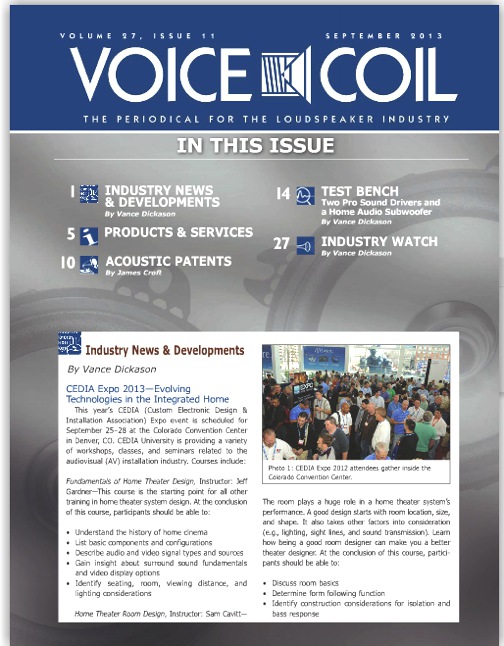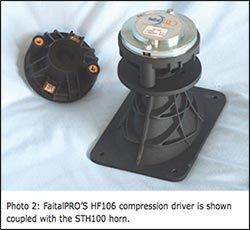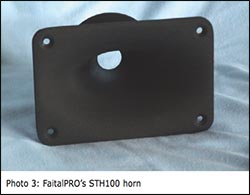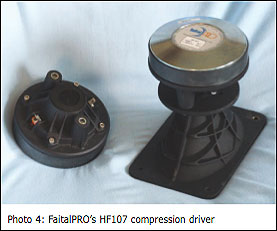 DOWNLOAD THE COMPLETE ARTICLE INCLUDING PHOTOS AND GRAPHICAL DATA
DOWNLOAD THE COMPLETE ARTICLE INCLUDING PHOTOS AND GRAPHICAL DATAVoice Coil (The periodical for the Loudspeaker industry) July 2013
For this month's Test Bench column, Voice Coil received two new compression drivers from FaitalPRO, the HF106 and the HF107, along with a FaitalPRO STH100 Elliptical Tractrix horn. Both the HF106 and the HF107 are new editions to a series of 1" diameter compression drivers, using Ketone polymer diaphragms. This series includes the HF100, the HF102, the HF104 (see Voice Coil March 2012), and the HF105 (see Voice Coil December 2012). The entire series is designed to be used with the STH100 horn. These compression drivers represent different power-handling ratings and recommended crossover frequencies. The HF100 and the HF102 are rated at 30 W, while the HF104 and the HF105 are rated at 40 W. This month's new FH106 is rated at 60 W. The HF107 is rated at 70 W.
The FaitalPRO HF106
The first Faital driver I examined was the HF106 compression driver, coupled with Faital's STH100 horn (see Photo 2). The HF106, like the entire series, is an interesting compression driver that shares several unique features with the other models. Its features include a Ketone polymer annular-shaped diaphragm and an annular-shaped phase plug (note the HF100, the HF104, and the HF105 use radial-shaped phase plugs).
Photo 2: FaitalPRO'S HF106 compression driver is shown coupled with the STH100 horn.
Photo 3: FaitalPRO's STH100 horn
Photo 4: FaitalPRO's HF107 compression driver
The driver's throat diameter is 25.4 mm (1") with the diaphragm coupled to a 44 mm (1.73") diameter voice coil wound on a Kapton former with aluminum wire. Other features include a neodymium ring magnet, a cast aluminum body, 60-W AES-rated power handling (120-W maximum), and solderable aircraft terminals. The STH100 horn supplied with the HF106 driver has a 1" diameter throat with 80° horizontal x 70° vertical short elliptical tractrix flare (see Photo 3).



I used the LinearX LMS analyzer to produce the 200-point stepped sine wave impedance plot shown in Figure 1. The solid black curve shows the HF106 mounted on the STH100 horn and the dashed blue curve represents the compression driver without the horn. With a measured 5.4-Ohm Re, the HF106/STH100's minimum impedance was 7.65 Ohm at 8.9 kHz. For the next test sequence, I mounted the HF106/ STH100 combination in an enclosure with a 10" x 15" baffle and used a 100-point gated sine wave sweep to measure the horizontal and vertical on- and off-axis at 2.83 V/1 m.
Figure 2 displays the compression driver/ horn combination's on-axis frequency response. With a 110-dB, 1-W/1-m rated sensitivity, it has a 111.3-dB, 2.83-V/1-m peak output at 4.1 kHz. The sound pressure level (SPL) profile measures ±4.5 dB from 1 to 10 kHz. (The HF106's recommended crossover frequency is a 1.3-kHz minimum with a second-order network.) Since this horn's coverage is 80° horizontal x 70° vertical, you wouldn't expect much difference in the horizontal and vertical off-axis plots. Figure 3 shows the horizon-tal orientation. Figure 4 shows the vertical orientation.
For the remaining tests, I used the Listen SoundCheck software, the AmpConnect ISC analyzer, a 0.25" SCM microphone, and a power supply to measure the distortion and generate time frequency plots. For the distortion measurement, I mounted the HF106/STH100 combination with the same baffle I used for the frequency response measurements. I used a pink noise stimulus to set the SPL to 104 dB at 1 m (1.73 V) and placed the Listen microphone 10 cm from the horn's mouth to measure the distortion. This produced the distortion curves shown in Figure 8.
I used SoundCheck to get a 2.83-V/1-m impulse response for this driver and imported the data into Listen's SoundMap time-frequency software. The resulting cumulative spectral decay (CSD) waterfall plot is shown in Figure 9. The short-time Fourier transform (STFT) plot is shown In Figure 10.
The SoundMap software, supplied with SoundCheck 12.0, no longer supports the classic "MLSSA" waterfall curve orientation. I used the default orientation for both SoundMap plots, and I will continue to do so in the future. I have been told that the Ketone polymer diaphragm yields a smooth subjective performance. However, from the above data, the HF106/STH100 looks like a nice addition to FaitalPro's lineup of pro sound compression drivers.
The FaitalPRO HF107
I also examined the Faital's HF107 compression driver, again coupled with Faital's STH100 horn (see Photo 4). The HF107 has a 140-W power-handling capacity ferrite motor, and it is substantially more heavy and physically larger than the HF106 (the HF106 uses a neodymium ring magnet). Like the HF106, the HF107 is an interesting compression driver and it shares several unique features with the rest of this series. The HF107's features include a Ketone polymer annular-shaped diaphragm and an annular-shaped phase plug. Its throat diameter is 25A mm (1-) and it is coupled to a 44-mm (1.73") diameter voice coil wound on a Kapton former with aluminum wire. Other features include a cast aluminum body, a 70-W AES-rated power handling (140-W maximum), and solderable terminals. The horn supplied for the HF107 is the same one used with the HF106. The STH100 has a 1" diameter throat with 80° horizontal x 70° vertical short elliptical tractrix flare. I used the LinearX LMS analyzer to produce the 200-point stepped sine wave impedance plot shown in Figure 11. The solid black curve was taken with the HF107 mounted on the STH100 horn and the dashed blue curve represents the compression driver without the horn. With a 5.4-Ohm DCR, the HF107/STH100's minimum impedance was 6.97 Ohm at 8.55 kHz. For the next frequency response tests, I recess mounted the Faital HF107/STH100 in an enclosure with a 10" x 15" baffle. Then, I used a 100-point gated sine wave sweep to measure the horizontal and vertical on- and off-axis at 2.83 V/1 m. Figure 12 shows the on-axis of the compression driver/ horn combination. The SPL profile measures ±4.48 dB from 1 kHz to 10 kHz. (The HF107's recommended crossover frequency is a minimum of 1.3 kHz with a second-order network.) As with the HF106's off-axis test, this horn's coverage was 80° horizontal x 70° vertical. You wouldn't expect much difference in the horizontal and vertical off-axis plots, which confirmed in Figure 13 for the horizontal orientation and Figure 14 for the vertical orientation. Figure 13's plot with the off-axis normalized to the on-axis response is shown in Figure 15. Figure 14's plot with the off-axis normalized to the on-axis response is shown in Figure 16.
Figure 17 shows the two-sample SPL comparison, confirming that both samples are closely matched. For the remaining tests, I used the Listen AmpConnect ISC analyzer and 0,25" SCM microphone to measure distortion and generate time frequency plots. For the distortion measurement, I mounted the HF107/STH100 combination with the same baffle I used for the frequency response measurements. I used a pink noise stimulus to set the SPL set to 104 dB at 1 m (1.7 V) and placed the Listen microphone 10 cm from the horn's mouth to measure the distortion. This produced the distortion curves shown in Figure 18. I then used SoundCheck to get a 2.83-V/1-m impulse response for this driver and imported the data into Listen SoundMap Time/Frequency software (now integrated with SoundCheck 12.0). The resulting CSD waterfall plot is shown in Figure 19. The STFT plot is shown in Figure 20 Comparing the HF107/STH100 data to that of the HF106/STH100, the performance of both devices is quite good.










